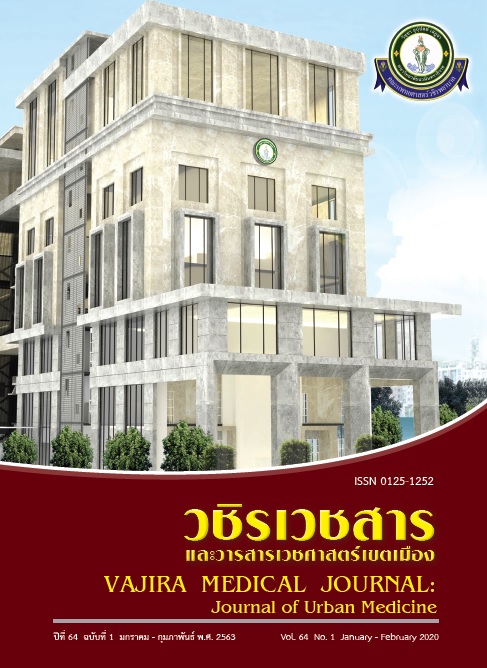The Prevalence and Pregnancy Outcomes of Short Cervix in Low Risk Singleton Pregnancy from Universal Cervical Length Screening
Main Article Content
Abstract
Objective: To study the prevalence of short cervix in low risk singleton pregnancy.
Methods: A retrospective descriptive study was conducted in 1099 low risk singleton pregnant women who came for antenatal care at 16-24 weeks of gestation during February 2016 to January 2017 by reviewing medical records. Pregnant women who had previous history of cervical incompetence, spontaneous preterm labor, preterm premature rupture of membranes (PPROM), Loop electrosurgical excision procedure (LEEP), conization and severe congenital anomaly or chromosomal abnormality were excluded. Transvaginal ultrasound for cervical length (CL) measurement referred to Society for Maternal-Fetal Medicine (SMFM) was performed. The short cervix was defined as CL less than or equal to 25 mm.
Results: The mean gestational age for CL measurement was 19.68±1.62 weeks of gestation and mean CL was 37.37±6.66 mm. The prevalence for short cervix ≤25, ≤20 and ≤15 mm was 1.73, 0.27 and 0.18 %, respectively. All pregnancy that had short cervix received micronize progesterone or 17-hydroxyprogesterone caproate (17OHP-C). Arabin pessary was used in six pregnancies and no case for cervical cerclage. Most of pregnancy delivered ≥37 weeks of gestation whereas preterm delivery was 6.46% (55/852) and late preterm was occurrences 4.23% (36/852). The major cause of preterm delivery was spontaneous preterm labor 47.27% (26/852) and preterm premature rupture of membrane 30.91% (17/852).
Conclusion: The prevalence of short cervix in low risk singleton pregnancy was 1.73%.
Downloads
Article Details
References
2. Cunningham FG, Leveno KJ, Bloom SL, Spong CY, Dushe JS, Hoffman BL, editors. Preterm labor. 24th ed. New York: McGraw-Hill; 2014.
3. Chawanpaiboon s, Sutantawibul A. Preterm Birth at Siriraj Hospital: A Seven-Year Review (2002-2008). Thai Journal of Obstetrics and Gynaecology 2009; 17: 204-11.
4. Pschirrer ER, Monga M. Risk Factors for Preterm labor. Clinical Obstetrics and Gynecology 2000;43(4): 727-34.
5. Hebbar S, Koirala S. Role of mid trimester transvaginal cervical ultrasound in prediction of preterm delivery. J Nepal Med Assoc 2006;45(164): 357-61.
6. Grimes-Dennis J, Berghella V. Cervical length and prediction of preterm delivery. Current Opinion in Obstetrics and Gynecology 2007;19: 191-5.
7. Iams J, Dildy G, Maconess G, Silverman N. Prediction and Prevention of Preterm Birth. Obstetrics & Gynecology 2012; 120(4): 964-73.
8. Society for Maternal-Fetal Medicine Publications Committee. The role of routine cervical length screening in selected high-and low risk women for Preterm birth prevention. Am J Obstet Gynecol 2016 Sep; 215(3): B2-7.
9. Khalifeh A, Berghella V. Universal cervical length screening in singleton gestation without a previous preterm birth: ten reasons hey it should be implemented. Am J Obstet Gynecol 2016; 214(5): 603.e1-5.
10. Goya M, Pratcorona L, Merced C, Rodo’ C, Valle L, Romero A, et al. Cervical pessary in pregnant women with a short cervix (PECEP) A randomized trial of a cervical pessary to prevent preterm singleton. Lancet 2012; 379:1800-6.
11. Nicolaides KH, Syngelaki A, Poon LC, Picciarelli G, Tul N, Zamprakou A, et al. A Randomized Trial of a Cervical Pessary to Prevent Preterm Singleton Birth. N Engl J Med 2016; 374: 1044-52.
12. Society for Maternal-Fetal Medicine Publications Committee. The role of cervical pessary placement to prevent preterm birth in clinical practice. Am J Obstet Gynecol 2017; 216(3):B8-B10.
13. Temming LA, Durst JK, Tuuli MG, Stout MJ, Dicke JM, Mancones GA, et al. Universal cervical length screening: implementation and out-comes. Am J Obstet Gynecol 2016; 214:523.e1-8.
14. American College of Obstetrics and Gynecology, Task Force on Neonatal Encephalopathy; American Academy of Pediatrics. Neonatal Encephalopathy and Neurologic Outcome, 2nd edition. Washington, CD: American College of Obstetricians and Gynecologists; 2014.
15. Emily SM, Alan TT, William AG. Second-Trimester Cervical Length Screening Among Asymptomatic Women. Obstetrics & Gynecology 2015; 126(1): 61-66.
16. Moeun S, William AG, Nina KA, Emily SM. A universal mid-trimester transvaginal cervical length screening program and its associated reduced preterm birth rate. Am J Obstet Gynecol 2016; 214: 365 e1-5.
17. Malipati M, Chunyan S, Xiaoxiao Z, Lixin F. The prevalence of short cervix between 20 and 24 weeks of gestation and vaginal progesterone for prolonging of gestation.J Matern Fetal Neonatal Med 2017; 30(14):1646-49.
18. American College of Obstetricians and Gynecologists; Committee on Practice Bulletins-Obstetrics. No 130: Prediction and Prevention of Preterm Birth. Obstet Gynecol 2012; 120:964-73.
19. Society for Maternal Fetal Medicine Publication Committee. The choice of progestogen for the prevention of preterm birth in women with singleton pregnancy and prior preterm birth. Am J Obstet Gynecol 2017; 216(3): 11-3.
20. Saccone G, Maruotti GM, Gliudicepietro A, Martinelli P. Effect of Cervical Pessary on Spontaneous Preterm Birth in Women with Singleton Pregnancies and Short Cervical Length A Randomized Clinical Trial. JAMA 2017;318(23): 2317-24.


